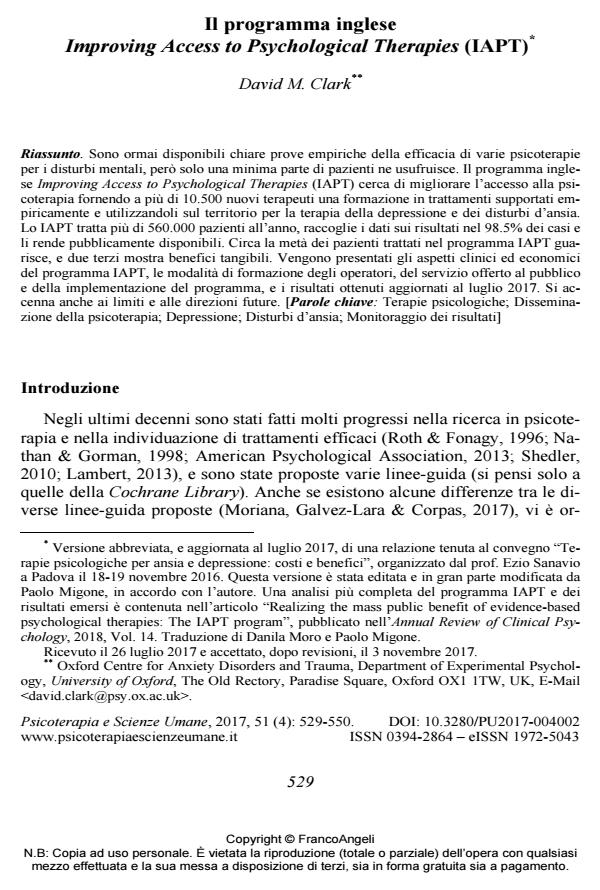Il programma inglese - Improving Access to Psychological Therapies (IAPT)
Titolo Rivista PSICOTERAPIA E SCIENZE UMANE
Autori/Curatori David M. Clark
Anno di pubblicazione 2017 Fascicolo 2017/4
Lingua Italiano Numero pagine 22 P. 529-550 Dimensione file 93 KB
DOI 10.3280/PU2017-004002
Il DOI è il codice a barre della proprietà intellettuale: per saperne di più
clicca qui
Qui sotto puoi vedere in anteprima la prima pagina di questo articolo.
Se questo articolo ti interessa, lo puoi acquistare (e scaricare in formato pdf) seguendo le facili indicazioni per acquistare il download credit. Acquista Download Credits per scaricare questo Articolo in formato PDF

FrancoAngeli è membro della Publishers International Linking Association, Inc (PILA)associazione indipendente e non profit per facilitare (attraverso i servizi tecnologici implementati da CrossRef.org) l’accesso degli studiosi ai contenuti digitali nelle pubblicazioni professionali e scientifiche
Sono ormai disponibili chiare prove empiriche della efficacia di varie psicoterapie per i disturbi mentali, però solo una minima parte di pazienti ne usufruisce. Il programma inglese Improving Access to Psychological Therapies (IAPT) cerca di migliorare l’accesso alla psicoterapia fornendo a più di 10.500 nuovi terapeuti una formazione in trattamenti supportati empiricamente e utilizzandoli sul territorio per la terapia della depressione e dei disturbi d’ansia. Lo IAPT tratta più di 560.000 pazienti all’anno, raccoglie i dati sui risultati nel 98.5% dei casi e li rende pubblicamente disponibili. Circa la metà dei pazienti trattati nel programma IAPT guarisce, e due terzi mostra benefici tangibili. Vengono presentati gli aspetti clinici ed economici del programma IAPT, le modalità di formazione degli operatori, del servizio offerto al pubblico e della implementazione del programma, e i risultati ottenuti aggiornati al luglio 2017. Si accenna anche ai limiti e alle direzioni future.
Parole chiave:Terapie psicologiche; Disseminazione della psicoterapia; Depressione; Disturbi d’ansia; Monitoraggio dei risultati
- Oltre la 180. Beyond the Italian Law no. 180/1978 on psychiatric reform Ivan Cavicchi, in PSICOTERAPIA E SCIENZE UMANE 4/2022 pp.571
DOI: 10.3280/PU2022-004004 - Dalla montagna al topolino: commento a ‘Consensus conference sulle terapie psicologiche per ansia e depressione’ Silvia Paola Papini, Fabio Vanni, in Ricerca Psicoanalitica /2023
DOI: 10.4081/rp.2023.793 - Sul rinnovamento della psicoanalisi Giorgio Meneguz, in PSICOTERAPIA E SCIENZE UMANE 2/2023 pp.213
DOI: 10.3280/PU2023-002003 - Il burnout del terapeuta Margherita Spagnuolo Lobb, in QUADERNI DI GESTALT 1/2023 pp.7
DOI: 10.3280/GEST2023-001001 - Un New Deal per le terapie psicodinamiche: lo psicoanalista come burocrate di strada Jeremy Clarke, in PSICOTERAPIA E SCIENZE UMANE 2/2024 pp.199
DOI: 10.3280/PU2024-002002 - Psychodynamic therapy in the public sector in Italy: then and now. The opportunity of evidence-based practice in the birthplace of ‘care-in-the-community’ Paolo Migone, in Psychoanalytic Psychotherapy /2020 pp.147
DOI: 10.1080/02668734.2020.1825013 - Riuscire a ottenere un beneficio di massa tramite l'offerta di terapie psicologiche: l'esperienza del programma inglese. Improving Access to Psychological Therapies (IAPT) David M. Clark, in PSICOTERAPIA E SCIENZE UMANE 1/2023 pp.93
DOI: 10.3280/PU2023-001011
David M. Clark, Il programma inglese - Improving Access to Psychological Therapies (IAPT) in "PSICOTERAPIA E SCIENZE UMANE" 4/2017, pp 529-550, DOI: 10.3280/PU2017-004002